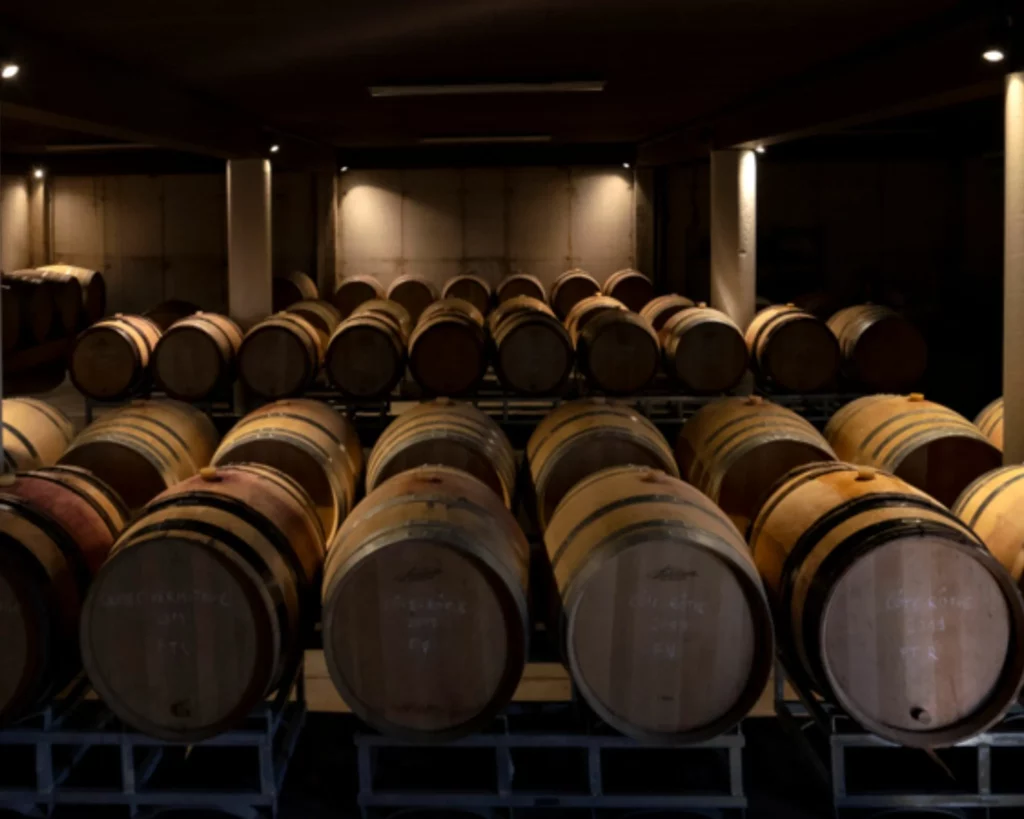Oak barrel ageing is a decisive stage in the construction of a wine's sensory profile. In particular, new oak barrels play a central role in the evolution of the wine's tannins and final aromatic expression. Understanding their impact enables us to appreciate the complexity and richness of a well-aged wine.
Why use new oak barrels?
New oak is sought after for its ability to enrich the wine. It contributes distinct aromatic compounds, notably vanillin, lactones and volatile phenols. These elements have a profound influence on the wine's olfactory identity.
In addition to aroma, new oak affects texture. It refines tannins, making them more supple. This transformation takes place slowly, as the wine ages in oak, thanks to exchanges between the liquid, the wood and the ambient oxygen.
Wood tannins transform wine structure
The tannins naturally present in the grapes blend with those released by the oak. This marriage structures the palate and lengthens the finish. New oak transmits condensed, more powerful tannins, which need time to integrate.
A young wine aged in oak barrels can seem harsh if tasted too soon. Aging in oak requires patience. The harmony between the tannins of the grape and those of the barrel is achieved after several months.
Aromas brought on by wood ageing
Each new barrel influences the wine according to its origin, toasting and the type of oak used. The finer French oak gives notes of vanillaalmond, even light tobacco. American oak is more generous, releasing aromas of coconut and caramel.
The aromas produced by wood ageing also vary according to the length of contact. After 6 to 12 months, subtle woody nuances emerge. After that, tertiary aromas dominate: sweet spices, toast, cocoa.
Slow oxygenation in barrel: an effect on roundness
Unlike stainless steel or concrete, oak barrels allow controlled oxygenation. This phenomenon softens the wine. It helps polymerize tannins and stabilize color.
The oxygen supply remains minimal but essential. It prevents excessive reduction. It stimulates the wine's natural evolution towards more complex aromas and velvety textures.
What proportion of new oak barrels should I choose?
The use of new barrels must be adapted to the style of the wine. A powerful, tannic wine is best aged in new barrels. Great Bordeaux wines, structured Malbecs or Syrahs lend themselves well to this.
Conversely, a light or fruity wine quickly becomes saturated. The wood tannins then dominate the fruit. In this case, barrel aging for one or two wines is preferable.
Length of wood ageing: a decisive parameter
The longer the wine is aged in oak, the more it takes on the tannins and aromas of the barrel. Short maturation periods (6 months) add a woody touch. Long ageing (18 months or more) transforms the wine profoundly.
The winemaker adjusts the duration according to grape variety, grape maturity and wine strength. A balance is sought: sublimation without masking.
New barrels and typicality: a delicate balance

New wood can magnify a wine. But it can also erase its identity. Too much barrel risks standardization. The wine loses its link to the terroir.
Good wood ageing respects the fruit. It accompanies the structure without masking the primary aromas. The winemaker's challenge is to find the right balance between power and finesse.
White wine and barrels: a more subtle use
Even white wines can benefit from ageing in oak barrels. Great Burgundies and Rhône whites are proof of this. Contact with wood rounds out acidity and enriches texture.
But here again, moderation is crucial. Too much wood dries out the wine, crushing it. A barrel with too much toast covers up floral or fruity notes. The winemaker must listen to the wine.
Barrel maintenance and renewal
An oak barrel has a limited ageing life. After three to five wines, it loses its aromas. It becomes neutral. Its role then becomes purely structural.
The estates renew their stock every year, often at a rate of 20-30%. This ensures a good balance between new and used wood in the final blend.
Cost of wood rearing: a well-considered investment
The use of new oak barrels comes at a high price. A French barrel can cost up to 1,000 euros. This strategic choice is part of a qualitative vision for the estate.
A top-of-the-range wine justifies this investment. It is aimed at a clientele capable of appreciating the work of wood on matter. The wine gains in prestige, complexity and ageing potential.
Wood and bottle ageing
Wines aged in new barrels often have superior ageing potential. Its tannins, enriched and stabilized, evolve slowly. Aromas gain in depth with age.
But beware: not all wines age well. There has to be enough substance. Otherwise, the wine quickly becomes unbalanced after bottling.
If you enjoyed this article, don't hesitate to read the following one "Foie gras and wine: should you always opt for a sweet wine?"which may also be of interest to you!





